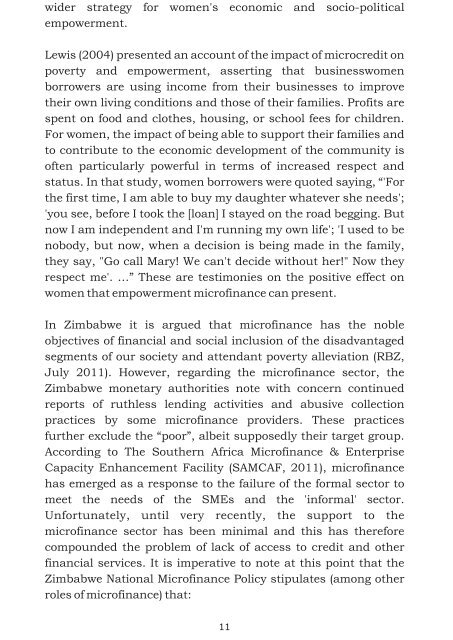Beneficiaries are actors too.pdf - Southern Institute of Peace ...
Beneficiaries are actors too.pdf - Southern Institute of Peace ...
Beneficiaries are actors too.pdf - Southern Institute of Peace ...
You also want an ePaper? Increase the reach of your titles
YUMPU automatically turns print PDFs into web optimized ePapers that Google loves.
wider strategy for women's economic and socio-political<br />
empowerment.<br />
Lewis (2004) presented an account <strong>of</strong> the impact <strong>of</strong> microcredit on<br />
poverty and empowerment, asserting that businesswomen<br />
borrowers <strong>are</strong> using income from their businesses to improve<br />
their own living conditions and those <strong>of</strong> their families. Pr<strong>of</strong>its <strong>are</strong><br />
spent on food and clothes, housing, or school fees for children.<br />
For women, the impact <strong>of</strong> being able to support their families and<br />
to contribute to the economic development <strong>of</strong> the community is<br />
<strong>of</strong>ten particularly powerful in terms <strong>of</strong> increased respect and<br />
status. In that study, women borrowers were quoted saying, “'For<br />
the first time, I am able to buy my daughter whatever she needs';<br />
'you see, before I <strong>too</strong>k the [loan] I stayed on the road begging. But<br />
now I am independent and I'm running my own life'; 'I used to be<br />
nobody, but now, when a decision is being made in the family,<br />
they say, "Go call Mary! We can't decide without her!" Now they<br />
respect me'. …” These <strong>are</strong> testimonies on the positive effect on<br />
women that empowerment micr<strong>of</strong>inance can present.<br />
In Zimbabwe it is argued that micr<strong>of</strong>inance has the noble<br />
objectives <strong>of</strong> financial and social inclusion <strong>of</strong> the disadvantaged<br />
segments <strong>of</strong> our society and attendant poverty alleviation (RBZ,<br />
July 2011). However, regarding the micr<strong>of</strong>inance sector, the<br />
Zimbabwe monetary authorities note with concern continued<br />
reports <strong>of</strong> ruthless lending activities and abusive collection<br />
practices by some micr<strong>of</strong>inance providers. These practices<br />
further exclude the “poor”, albeit supposedly their target group.<br />
According to The <strong>Southern</strong> Africa Micr<strong>of</strong>inance & Enterprise<br />
Capacity Enhancement Facility (SAMCAF, 2011), micr<strong>of</strong>inance<br />
has emerged as a response to the failure <strong>of</strong> the formal sector to<br />
meet the needs <strong>of</strong> the SMEs and the 'informal' sector.<br />
Unfortunately, until very recently, the support to the<br />
micr<strong>of</strong>inance sector has been minimal and this has therefore<br />
compounded the problem <strong>of</strong> lack <strong>of</strong> access to credit and other<br />
financial services. It is imperative to note at this point that the<br />
Zimbabwe National Micr<strong>of</strong>inance Policy stipulates (among other<br />
roles <strong>of</strong> micr<strong>of</strong>inance) that:<br />
11


